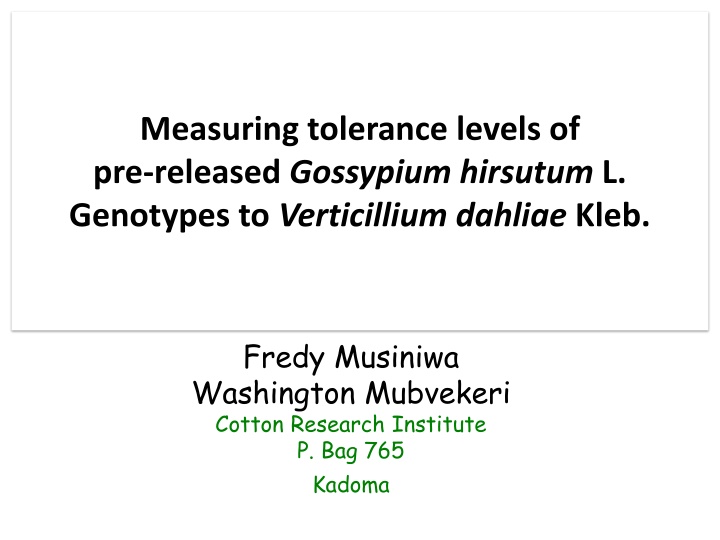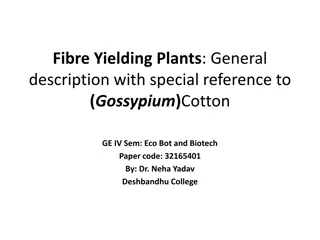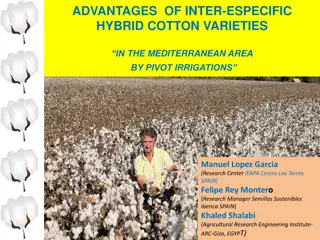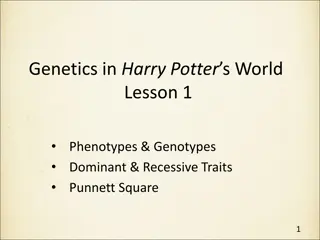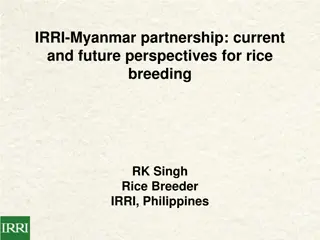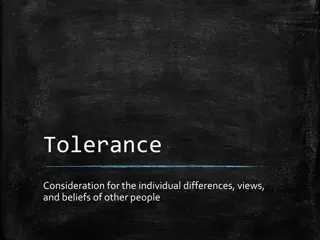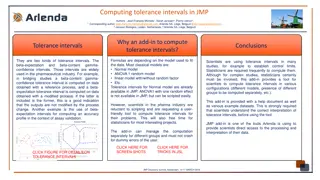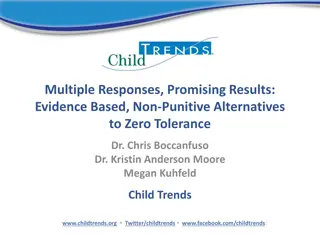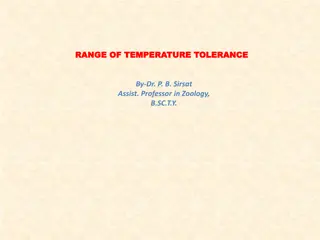Tolerance Levels of Gossypium hirsutum L. Genotypes to Verticillium dahliae Kleb.
The study aims to measure the tolerance levels of pre-released Gossypium hirsutum L. genotypes to Verticillium dahliae Kleb, a soil-borne fungus causing Verticillium wilt in cotton. The research, conducted at the Cotton Research Institute, focuses on determining tolerance levels of new cotton genotypes to Verticillium wilt through incidence, severity, and seed cotton yield measurements. Various breeding programs and experiments were carried out, with efforts to find tolerant cultivars for effective disease control in cotton production.
Download Presentation

Please find below an Image/Link to download the presentation.
The content on the website is provided AS IS for your information and personal use only. It may not be sold, licensed, or shared on other websites without obtaining consent from the author.If you encounter any issues during the download, it is possible that the publisher has removed the file from their server.
You are allowed to download the files provided on this website for personal or commercial use, subject to the condition that they are used lawfully. All files are the property of their respective owners.
The content on the website is provided AS IS for your information and personal use only. It may not be sold, licensed, or shared on other websites without obtaining consent from the author.
E N D
Presentation Transcript
Measuring tolerance levels of pre-released Gossypium hirsutum L. Genotypes to Verticillium dahliae Kleb. Fredy Musiniwa Washington Mubvekeri Cotton Research Institute P. Bag 765 Kadoma
Introduction Verticillium wilt is one of the most important diseases of cotton which affects yield and fibre quality in cotton worldwide (Karademir et al., 2010). The disease is caused by a soil borne fungus called Verticillium dahliae Kleb Once verticillium wilt is introduced into the field, eradicating it is difficult because of its saprophytic ability
Introduction there is no effective chemical control for the disease. the use of tolerant cultivars is of great importance in controlling the disease. Measuring V. wilt tolerance levels in new cotton genotypes is one of the major breeding goals at Cotton Research institute
Objective To determine tolerance levels of new cotton genotypes verticillium wilt. to
Materials and Methods Study site Cotton Research Institute 2 Experiments from MSHV breeding programs Treatments- 12 cotton genotypes Experimental Design- RCBD with 3 Reps Plot size- single row of 5.4m Measurements- %incidence, severity and seed cotton yield
Materials and Methods Infected plants were tagged with knitting wool of colours period of February up to May. Table 1. Scoring system for percentage incidence different from % Incidence 0% - 9% Disease Rating Symbol the Highly Resistant Resistant HR 10% - 19% R Percentage was every plot at the end of the season incidence calculated per 20% - 29% Tolerant T >30% Susceptible S
Materials and Methods Vascular browning was determined by cutting each plant cross sectionally after harvesting. Yield was measured per plot at the end of the season.
Materials and methods Fig 1: Vascular browning index for assessing disease severity 0 = no discolouration 1 = discolouration restricted to small spots or an area less than 5% of the stem cross section 2 = discolouration of between 5% and 20% of the stem cross section 3 = discolouration of between 20% and 40% of the stem cross section 4 = greater than 40% vascular discolouration of the stem cross section Source (Australian Cotton CRC. 2008.)
Materials and Methods Data analysis Data on Incidence and severity was transformed using Arcsine and square root transformations respectively. Anova was conducted using Genstat 14th edition Mean separation was done using the Duncan Multiple Range Test at 5% level
Table 2: Verticillium wilt incidence, in MSHV1 trial conducted at CRI during 2015-16 seasons. 70 60 % Disease Incidence 50 40 30 2014-15 2015-16 20 10 0 Cotton Genotypes
Table 3: Verticillium wilt severity and yield in MSHV1 trial conducted at CRI during 2015-16 seasons. Season 2015 2016 2015-16 Genotype Disease severity index Disease severity index Yield Kg/ha K602 97-05-1 SZ9314 1.132b 1.527c 1.311bc 0.300ab 0.800bc 0.200a 2131 2075 1467 BC853 1.125b 0.333ab 1570 651-01-1 562-00-9 1.262bc 0.812a 0.533ab 0.567ab 1041 1609 566-99-23 CRI-MS-1 1.190b 1.191b 1.100c 0.767bc 1401 1645 931-05-9 1.435bc 0.533ab 1279 665-01-3 QM301 816-01-1 Grand mean P value CV 1.398bc 1.168b 1.188b 0.778 0.008 14.2 0.733abc 0.333ab 0.400ab 0.6 0.029 31 1739 2052 1094 1592 0.212 29
Medium Staple Middle Veld Varieties MSHV4
Table 3: Verticillium wilt incidence, severity and yield in MSHV4 trial conducted at CRI during 2015-16 seasons. 80 70 60 % Disease Incidence 50 40 30 2014-15 2015-16 20 10 0 Cotton Genotypes
Table 3: Verticillium wilt severity and yield in MSHV4 trial conducted at CRI during 2015-16 seasons. Season Genotype K602 BC853 2015 Disease severity index 1.00ab 1.733bcd 2016 Disease severity index 0.700 1.000 2015 Yield Kg/ha 3880c 1028ab 2016 Yield Kg/ha 1142abc 846ab 917-05-7 932-00-3 GN96(b)-05-8 648-01-4 1.900cd 0.567a 1.167abc 1.033ab 0.900 0.900 0.400 0.400 1654ab 2386bc 2438bc 3687b 988ab 1679c 1228bc 1377bc 912-05-1 280-94-10 TN96-05-9 CRI-MS-1 2.233d 1.800bcd 1.967cd 1.233abc 0.600 0.400 0.400 1.100 213a 1160ab 1718ab 1790ab 633a 886ab 1392bc 1269bc QM301 938-05-3 1.267abc 2.167d 1.000 0.500 1247ab 117a 1358bc 957ab Grand mean P value CV 1.506 0.002 29.2 0.700 0.099 31 1609 0.002 33 1146 0.018 26.4
Conclusion Verticillium wilt screening indicated that varieties had different tolerant levels to the disease. Most genotypes which were tolerant to the disease produced high yields. MSHV1-562-00-9 MSHV6-932-00-3, GN96(b)-05-8 and 648-01-4
Recommendations Genotypes GN96(b)-05-8,932-00-3, 648-01-4 and 562-00-9 are recommended for further breeding advancement. Further research to determine the mode of tolerance
The end Thank You!!!
